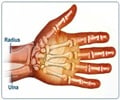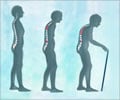Lifestyle and Osteoporosis Symptoms
Osteoporosis is often called a "silent disease" because bone loss occurs without symptoms. People may not know that they have osteoporosis until their bones become so weak that a sudden strain, bump or fall causes a fracture or a vertebra to collapse. Collapsed vertebrae may initially be felt or seen in the form of severe back pain, loss of height, or spinal deformities such as kyphosis or stooped posture.
The risk zone
Although any one can be affected there are certain factors that aggravate the occurrence of the disease. These are known as risk factors and people within these criterion known to be in the risk zone.
- Personal history of fracture after age 50
- Current low bone mass
- History of fracture in a 1° relative
- Being female
- Being thin and/or having a small frame
- Advanced age
- A family history of osteoporosis
- Estrogen deficiency as a result of menopause, especially early or surgically induced
- Abnormal absence of menstrual periods (amenorrhea)
- Anorexia nervosa
- Low lifetime calcium intake
- Vitamin D deficiency
- Use of certain medications (corticosteroids, chemotherapy, anticonvulsants and others)
- Presence of certain chronic medical conditions
- Low testosterone levels in men
- An inactive lifestyle
- Current cigarette smoking
- Excessive use of alcohol
- Being Caucasian or Asian, although African Americans and Hispanic Americans are at significant risk as well











